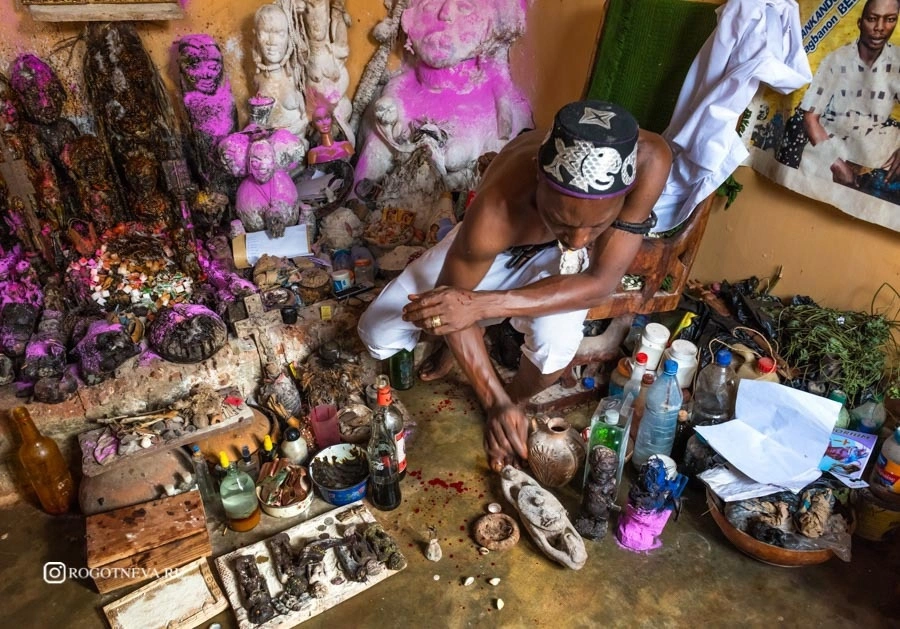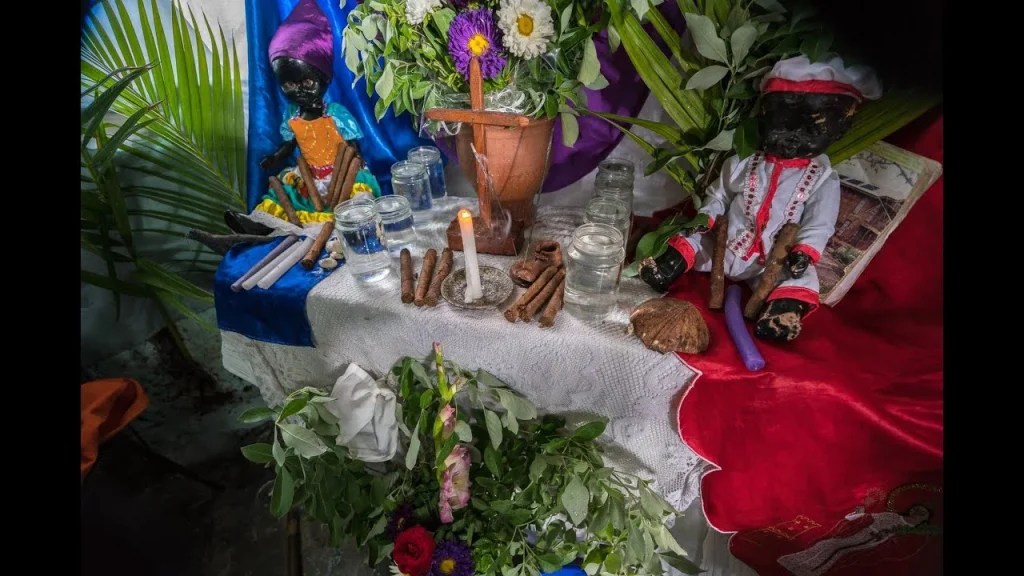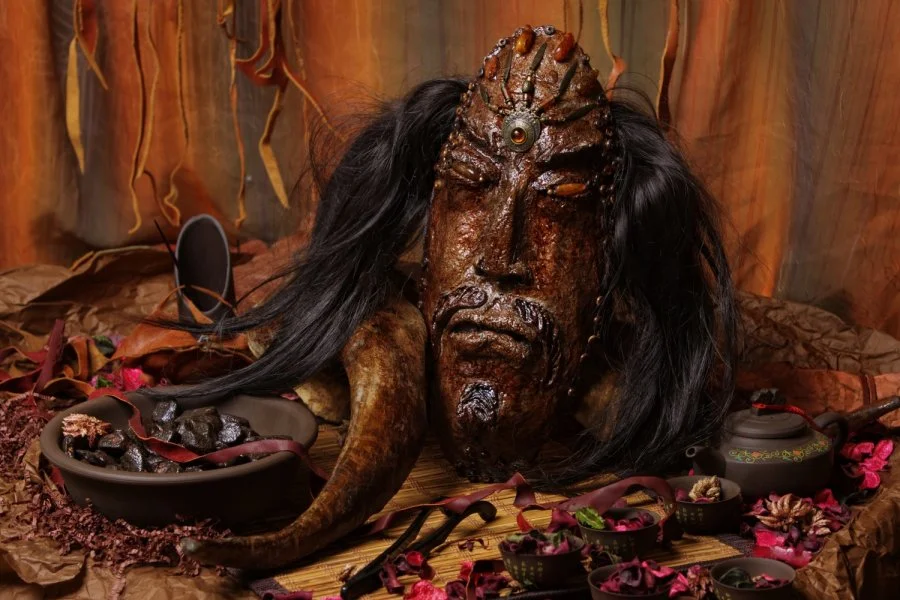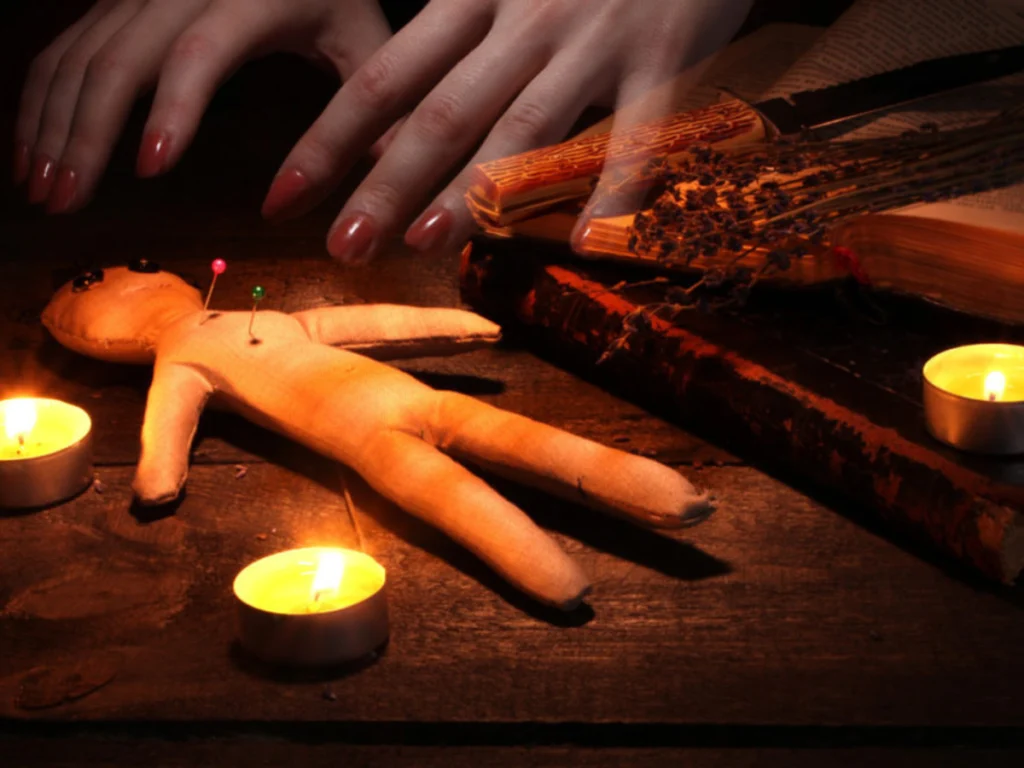Santeria witchcraft, also known as Regla de Ocha, La Regla Lukumi, or simply Lukumi, is a syncretic religion that originated in Cuba but has since spread throughout the Americas and beyond. It combines elements of West African Yoruba religion with Roman Catholicism, resulting in a unique and diverse belief system. One of the intriguing facets of Santeria is its connection to witchcraft, which is a topic that often sparks curiosity and misunderstanding. In this article, we will delve into the world of Santeria witchcraft to shed light on its practices, beliefs, and misconceptions.
The Origins of Santeria Witchcraft
The origins of Santeria witchcraft are deeply intertwined with the historical context of the transatlantic slave trade, African spirituality, and the syncretic nature of the religion itself. To understand the roots of Santeria witchcraft, we need to explore these aspects in more detail:
- African Ancestry: Santeria’s foundation lies in the African Yoruba religion, which originated among the Yoruba people in what is now modern-day Nigeria and Benin. Yoruba religion is a polytheistic belief system with a pantheon of deities known as “orishas.” These orishas play a central role in Yoruba spirituality, governing various aspects of human life and the natural world. Yoruba religion also includes divination, ancestor veneration, and the use of herbs and natural remedies for healing.
- The Transatlantic Slave Trade: During the transatlantic slave trade, millions of African slaves were forcibly transported to the Americas, including Cuba. Among these slaves were individuals who practiced the Yoruba religion. Despite the harsh conditions of slavery, they managed to preserve their spiritual traditions by disguising their orishas as Catholic saints and incorporating Catholic imagery and rituals into their practices. This blending of Yoruba spirituality with Catholicism laid the foundation for Santeria as a syncretic religion.
- Syncretism and Adaptation: The fusion of Yoruba spirituality with Catholicism was not a mere superficial overlay but a profound adaptation that allowed African slaves to continue practicing their beliefs while appearing to conform to the dominant religion of the time. Each Catholic saint came to represent a specific orisha, and the two belief systems became intertwined. This syncretism is a defining feature of Santeria and is evident in its rituals, iconography, and even the use of Latin prayers.
- Witchcraft in Yoruba Tradition: Yoruba culture has a longstanding tradition of spiritual practices that could be categorized as witchcraft. Yoruba priests and priestesses, known as “babalawos” and “iyalawos,” are skilled in divination, healing, and spellwork. These practitioners serve as intermediaries between humans and orishas, much like Santeria witches. Yoruba witchcraft, however, is firmly rooted in the Yoruba cosmology and worldview, emphasizing the balance of spiritual forces and the harmony of the universe.
- Evolution in the New World: Over time, Santeria continued to evolve and adapt in the New World, absorbing elements from other African traditions, indigenous beliefs, and even European mysticism. This evolution gave rise to diverse practices within the Santeria community, including herbs for witchcraft, herbalism, and various forms of divination.
In summary, Santeria witchcraft has its origins in the Yoruba spirituality of West Africa, brought to the Americas by African slaves during the transatlantic slave trade. The syncretic nature of Santeria allowed these individuals to adapt their beliefs to the new environment while preserving essential elements of their ancestral religion. Witchcraft within Santeria, much like in Yoruba tradition, encompasses divination, healing, spellwork, and spiritual guidance, all deeply connected to the worship of orishas and the pursuit of spiritual growth and well-being and there is even more about prayer against witchcraft.


The Role of Witchcraft in Santeria
The role of Santeria witchcraft, often referred to as “brujeria,” is multifaceted and plays a significant part in the religious and spiritual life of Santeria practitioners. It encompasses a wide range of practices and rituals that are deeply rooted in the syncretic blend of Yoruba spirituality and Catholicism. Here’s a closer look at the various aspects of witchcraft in Santeria:
- Healing and Divination: Santeria witchcraft places a strong emphasis on healing symbols, both physical and spiritual. Practitioners, known as “brujos” (male) and “brujas” (female), are skilled in the use of herbs, natural remedies, and divination methods to diagnose and treat illnesses. They may employ techniques such as reading cowrie shells, tarot cards, or the use of divination tools like the “diloggun” (a set of sacred cowrie shells) to gain insights into an individual’s spiritual and physical well-being.
- Rituals and Spells: Santeria witchcraft involves a variety of rituals and spells designed to invoke the assistance of the orishas, who are considered intermediaries between humans and the divine. These rituals are highly ceremonial and often incorporate dance, music, offerings, and the use of sacred objects such as ritual drums, candles, and incense. Santeria witches use their knowledge and connection with the orishas to facilitate positive change in the lives of individuals. These changes can range from love and prosperity to protection from negative influences.
- Protection and Cleansing: Santeria witchcraft places a strong emphasis on protection from malevolent forces and negative energies. Practitioners may create amulets, talismans, or protective spells to ward off harm and negative influences. Cleansing rituals, known as “limpias,” are also an integral part of Santeria witchcraft. These rituals are performed to purify the soul, remove negative attachments, and restore spiritual balance.
- Communication with Spirits: Santeria witches often serve as intermediaries between the physical world and the spirit world. They may communicate with spirits, including deceased ancestors, to seek guidance, offer respect, and honor their presence. This practice is deeply rooted in African and indigenous traditions of ancestor veneration.
- Initiation and Training: Becoming a Santeria witch typically involves a process of initiation and training under the guidance of an experienced practitioner. Initiates are introduced to the rituals, spells, and divination techniques of the tradition and may receive guidance from a spiritual mentor, (it can’t be used for Forbidden Demon Spells).
- Offerings and Sacrifice: Some Santeria rituals involve animal sacrifices, typically chickens, goats, or other animals. These offerings are made to appease specific orishas and establish a spiritual connection. It’s important to note that animal sacrifices are performed with great care, reverence, and respect for the animals involved. They are not taken lightly and adhere to strict ethical guidelines within the tradition.
- Community and Cultural Identity: Santeria witchcraft is often practiced within the context of a close-knit community. It serves as a means of cultural identity and connection to one’s African and Afro-Caribbean heritage.
In conclusion, witchcraft in Santeria is a complex and spiritually rich aspect of the religion. It encompasses healing, divination, protection, communication with spirits, and a deep connection to the orishas. While it shares some similarities with other forms of witchcraft, it is fundamentally rooted in the syncretic blend of Yoruba spirituality and Catholicism, making it a unique and culturally significant tradition within the broader Santeria religious framework.


Rituals and Practices
Santeria witchcraft, like the broader Santeria religion, involves a variety of rituals and practices that are deeply rooted in both Yoruba spirituality and Catholicism. These rituals and practices are aimed at connecting with the orishas (deities), seeking their guidance, and addressing various aspects of life, including healing, protection, and spiritual growth. Here are some key rituals and practices associated with Santeria witchcraft:
- Altars and Shrines: Central to Santeria witchcraft is the creation of altars and shrines dedicated to specific orishas. Each orisha has its own attributes and preferences, and practitioners maintain altars adorned with symbolic items, candles, and offerings that are specific to the orisha they are venerating. These altars serve as a focal point for rituals and prayers.
- Offerings and Sacrifice: As part of their devotion, Santeria witches make offerings to the orishas to establish and maintain a spiritual connection. Offerings can include food, beverages, cigars, and other items that the particular orisha is believed to enjoy. In some cases, animal sacrifices are made, typically involving chickens, goats, or other animals. These sacrifices are performed with respect and ritual precision, and the meat is often shared in communal meals.
- Divination: Divination plays a crucial role in Santeria witchcraft. Various divination systems are used to seek guidance from the orishas and gain insights into an individual’s life. The “diloggun,” a set of sacred cowrie shells, is a popular divination tool. Other methods may include the use of tarot cards, palmistry, or numerology. The results of divination are used to determine appropriate courses of action and ritual work.
- Initiation and Training: Becoming a Santeria witch often involves a process of initiation, where the individual is introduced to the rituals, witch symbols, and practices of the tradition. Initiates undergo training and guidance from experienced practitioners or spiritual mentors. These initiations vary in complexity and significance, and they may require years of dedication and study.
- Dance and Music: Dance and music are integral components of Santeria rituals. Ceremonial drumming, singing, and dancing are used to invoke the presence of the orishas and create a spiritually charged atmosphere. The rhythms and movements are specific to each orisha, and they are considered a form of worship and communication.
- Cleansing and Purification: Santeria witchcraft places a strong emphasis on cleansing and purification rituals. These practices are intended to remove negative energy, spiritual impurities, and blockages. Ritual baths, herbal smudging, and other purification methods are commonly employed to restore spiritual balance and well-being.
- Spellwork and Magic: Santeria witches may perform spellwork for various purposes, including love, prosperity, protection, and healing. These spells often involve the use of candles, herbs, oils, and symbolic objects. The practitioner’s connection with the orishas is believed to empower these spells and rituals.
- Feast Days and Celebrations: Santeria observes numerous feast days and celebrations dedicated to specific orishas. These festivities often involve elaborate rituals, music, dance, and communal meals. Participants come together to honor the orisha being celebrated and seek their blessings.
- Communication with Ancestors: Ancestor veneration is an essential aspect of Santeria witchcraft. Practitioners communicate with deceased ancestors to seek their guidance and blessings. Altars for ancestors may include photographs, candles, and offerings of food and drink.
- Protection and Amulets: Santeria witches often create amulets, talismans, or protective charms to ward off negative energies and provide spiritual protection. These items are consecrated and imbued with specific intentions through rituals including I love you rituals.
Santeria witchcraft is a deeply spiritual and ritualistic practice that combines elements of African and Catholic traditions to foster a connection with the orishas and the divine. These spiritual rituals and practices are performed with reverence, respect, and a sense of devotion, and they play a vital role in the lives of Santeria practitioners.
Cultural Significance
Santeria holds immense cultural significance, particularly for communities with Afro-Caribbean heritage. It is a source of identity, spirituality, and resistance against historical oppression. Santeria provides a connection to ancestral roots, preserving and celebrating African traditions that were forcibly suppressed during slavery. It serves as a source of empowerment, resilience, and cultural preservation for generations seeking to reclaim their heritage.


How Has Santeria Witchcraft Been Influenced by Catholism
Santeria witchcraft has been influenced by Catholicism. Santeria is a syncretic religion that emerged from the blending of West African Yoruba traditions and Catholicism during the colonial period in Cuba. As a result, elements of Catholicism have been incorporated into Santeria witchcraft practices.
- Iconography: In Santeria, the Orishas (deities) are often associated with specific Catholic saints. This syncretism allowed the enslaved Africans to continue worshipping their Orishas while outwardly appearing to be practicing Catholicism. For example, the Orisha Oshun is associated with the Catholic saint Our Lady of Charity, and the Orisha Babalú Ayé is associated with St. Lazarus. The use of Catholic icons and imagery in Santeria rituals and altars reflects this blending of traditions.
- Ritual Practices: Santeria witchcraft incorporates certain Catholic ritual practices. For instance, processions, the use of candles, and the sprinkling of holy water can be found in Santeria ceremonies. While these practices have been adapted and reinterpreted within the context of Santeria, their origins can be traced back to Catholic rituals. sure we dont talk about Humiliation Rituals as Revenge.
- Liturgical Language: Santeria rituals may include the use of prayers, hymns, and invocations in Latin or Spanish, mirroring the Catholic liturgical language. This incorporation of Catholic linguistic elements adds a sense of familiarity and continuity with Catholicism, while the focus remains on the Orishas and their spiritual significance.
- Catholic Calendar: Santeria witchcraft acknowledges certain Catholic feast days and holidays. Santeros and santeras may incorporate these dates into their rituals and celebrations, aligning them with the liturgical calendar of Catholicism. This practice demonstrates the syncretic nature of Santeria, blending elements of both traditions it can also be in of Cord Cutting Rituals.
It is important to note that while Santeria witchcraft has been influenced by Catholicism, it retains its unique identity and practices. The incorporation of Catholic elements into Santeria reflects the historical context in which the religion developed and the adaptive nature of the enslaved Africans in preserving their spiritual traditions. Santeria remains a distinct and rich spiritual path that continues to evolve within its cultural framework.
Misconceptions About Santeria Witchcraft
Misconceptions about Santeria witchcraft abound due to a lack of understanding and often perpetuated by sensationalized portrayals in popular culture. It’s crucial to dispel these misconceptions to promote accurate knowledge and a more respectful perspective on this syncretic religious tradition. Here are some common misconceptions about Santeria witchcraft:
- Harmful Intentions: One of the most significant misconceptions is that Santeria witchcraft is inherently malevolent and seeks to harm others. In reality, the majority of Santeria practitioners use their skills for positive purposes, such as healing, protection, and spiritual guidance. Harmful practices are typically discouraged within the Santeria community, and those who engage in them are considered outliers.
- Black Magic and Curses: Santeria is often wrongly associated with “black magic” and the casting of curses. While some practitioners may use some type spells for defensive purposes or to address specific issues, the overwhelming focus is on maintaining spiritual balance, healing, and positive change in individuals’ lives. Curses are not a central aspect of Santeria witchcraft.
- Animal Sacrifice as Cruelty: The practice of animal sacrifice in Santeria rituals is frequently misunderstood as cruelty to animals. In reality, animal sacrifices are performed with great care and respect for the animals involved. The process is meant to be humane, and the meat is often consumed as part of communal meals or distributed to those in need.
- Witchcraft as Devil Worship: Santeria witchcraft is sometimes erroneously linked to devil worship due to its syncretic nature and the presence of Catholic imagery. However, Santeria practitioners do not worship the devil. Instead, they revere orishas, who are considered benevolent spirits or intermediaries between humans and the divine.
- Satanic Rituals: Some portrayals in popular culture depict Santeria rituals as satanic or demonic. This is a gross misrepresentation of the religion. Santeria is a legitimate and recognized religious tradition that draws on African, Catholic, and indigenous spiritual elements to connect with the divine.
- Association with Crime: Occasionally, Santeria has been unfairly associated with criminal activities, such as drug trafficking or illegal activities. These claims are unsubstantiated and baseless, as Santeria is a religion with its own moral and ethical principles.
- Secrecy and Mysterious Practices: Santeria is sometimes depicted as a secretive and mysterious cult with hidden agendas. While there are indeed aspects of the tradition that are private and reserved for initiates, this secrecy is common in many religious traditions and is not evidence of harmful intentions.
- Stereotyping and Stigmatization: The perpetuation of negative stereotypes and stigmatization of Santeria practitioners can lead to discrimination and misunderstanding. It’s essential to approach Santeria with an open mind and respect for its rich cultural and spiritual heritage.
In conclusion, misconceptions about Santeria witchcraft often stem from ignorance, fear, and misrepresentation in media and popular culture. To gain a more accurate understanding of Santeria, it’s essential to seek information from reputable sources, engage in respectful dialogue with practitioners, and recognize the diversity and complexity of this syncretic religious tradition.


Conclusion
Santeria witchcraft is a unique and complex aspect of the broader Santeria religion. It combines elements of Yoruba spirituality, Catholicism, and indigenous beliefs to create a diverse and rich tapestry of practices and rituals like magic money rituals. While it has often been misunderstood and sensationalized, it is important to approach Santeria with an open mind and a willingness to learn about its history, beliefs, and practices. By doing so, we can appreciate the depth and beauty of this syncretic religion and gain a more accurate understanding of its witchcraft traditions.

